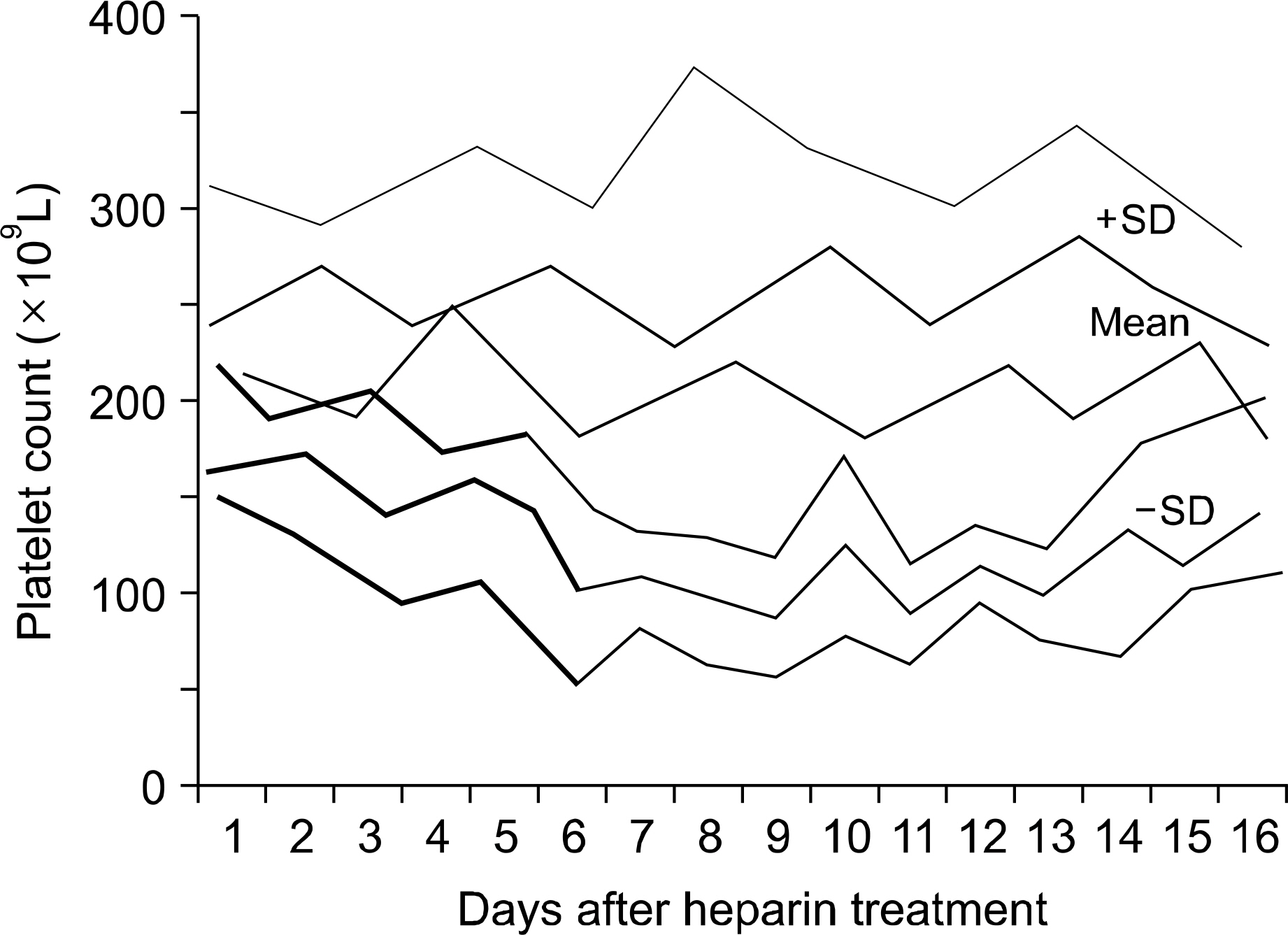Korean J Hematol.
2005 Mar;40(1):28-33. 10.5045/kjh.2005.40.1.28.
Heparin-Induced Thrombocytopenia (HIT) in Patients with Acute Coronary Syndrome: Incidence and Clinical Feature, Retrospective Study
- Affiliations
-
- 1Department of Internal Medicine, Gachon Medical School Gil Medical Center, Gil Heart Center, Incheon, Korea. hematoma@ghil.com
- KMID: 2252363
- DOI: http://doi.org/10.5045/kjh.2005.40.1.28
Abstract
- BACKGROUND
The aims of this study were to find the incidence and clinical features of Heparin-induced thrombocytopenia (HIT) in acute coronary syndrome patients treated with unfractionated heparin.
METHODS
The medical records of 554 patients treated with unfractionated heparin (UFH) for their coronary artery diseases at the Gachon Medical School Gil Heart Center during 2002~2003. were retrospectively reviewed. The gourp eligible group inclusion in this study was comprised of 338 patients with acute coronary syndrome.
RESULTS
The median duration of UFH administration was 6 days, ranging from 1 to 22 days. Among the eligible patients, 40 (11.8%) received UFH for > 96 hours, and developed thrombocytopenia, which involved a platelet count decrease to less than 100,000 per cubic millimeter or a 50% or greater decrease in the platelet count.
CONCLUSION
Despith the limitations of retrospective analyses, the present study shows that thrombocytopenia is relatively common in acute coronary syndrome patients treated with UFH, but did not account for HIT associated complication, such as thrombosis. When clinicians recognize the development of HIT without a thrombocytopenia related disease, many will stop the use of heparin for its management.
Keyword
MeSH Terms
Figure
Cited by 2 articles
-
Usefulness of anti-PF4/heparin antibody test for intensive care unit patients with thrombocytopenia
Sang Hyuk Park, Seongsoo Jang, Hyoeun Shim, Geum-Borae Park, Chan-Jeoung Park, Hyun-Sook Chi, Sang-Bum Hong
Korean J Hematol. 2012;47(1):39-43. doi: 10.5045/kjh.2012.47.1.39.A Case of Heparin Induced Thrombocytopenia with Circulating Anti-PF4/Heparin Antibody
Yangsoon Lee, Juwon Kim, Jaewoo Song, Kyoung Soon Song
Korean J Hematol. 2007;42(1):67-70. doi: 10.5045/kjh.2007.42.1.67.
Reference
-
1). Warkentin TE, Sheppard JA, Horsewood P, Simpson PJ, Moore JC, Kelton JG. Impact of the patient population on the risk for heparin-induced thrombocytopenia. Blood. 2000; 96:1703–8.
Article2). Chong BH. Heparin-induced thrombocytopenia. Br J Haematol. 1995; 89:431–9.3). Schmitt BP, Adelman B. Heparin-associated thrombocytopenia: a critical review and pooled analysis. Am J Med Sci. 1993; 305:208–15.
Article4). Warkentin TE, Levine MN, Hirsh J, et al. Heparin-induced thrombocytopenia in patients treated with low-molecular-weight heparin or unfractionated heparin. N Engl J Med. 1995; 332:1330–5.
Article5). Warkentin TE, Greinacher A. Heparin-induced thrombocytopenia and cardiac surgery. Ann Thorac Surg. 2003; 76:2121–31.
Article6). Warkentin TE, Kelton JG. Temporal aspects of heparin-induced thrombocytopenia. N Engl J Med. 2001; 344:1286–92.
Article7). Rice L, Attisha WK, Drexler A, Francis JL. Delayed-onset heparin-induced thrombocytopenia. Ann Intern Med. 2002; 136:210–5.
Article8). Warkentin TE, Kelton JG. Delayed-onset heparin-induced thrombocytopenia and thrombosis. Ann Intern Med. 2001; 135:502–6.
Article9). Wallis DE, Workman DL, Lewis BE, Steen L, Pifarre R, Moran JF. Failure of early heparin cessation as treatment for heparin-induced thrombocytopenia. Am J Med. 1999; 106:629–35.
Article10). Greinacher A, Janssens U, Berg G, et al. Lepirudin (recombinant hirudin) for parenteral anticoagulation in patients with heparin-induced thrombocytopenia. Heparin-Associated Thrombocytopenia Study (HAT) investigators. Circulation. 1999; 100:587–93.11). Lewis BE, Wallis DE, Leya F, Hursting MJ, Kelton JG. Argatroban-915 Investigators; Argatroban anticoagulation in patients with heparin-induced thrombocytopenia. Arch Intern Med. 2003; 163:1849–56.12). Hahn JS, Kim HS, Lee MS, Kim HK, Ko YW. A study on unfractionated heparin induced thrombocytopenia in the treatment of thrombotic diseases. Korean J Hemost Thromb. 1998; 5:155–60.13). Girolami B, Prandoni P, Stefani PM, et al. The incidence of heparin-induced thrombocytopenia in hospitalized medical patients treated with subcutaneous unfractionated heparin: a prospective cohort study. Blood. 2003; 101:2955–9.
Article14). Greinacher A, Eichler P, Lubenow N, Kwasny H, Luz M. Heparin-induced thrombocytopenia with thromboembolic complications: meta-analysis of 2 prospective trials to assess the value of parenteral treatment with lepirudin and its therapeutic aPTT range. Blood. 2000; 96:846–51.
Article15). Lubenow N, Kempf R, Eichner A, Eichler P, Carlsson LE, Greinacher A. Heparin-induced thrombocytopenia: temporal pattern of thrombocytopenia in relation to initial use or reexposure to heparin. Chest. 2002; 122:37–42.16). Lee DH, Warkentin TE. Frequency of heparin-induced thrombocytopenia. Warkentin TE, Greinacher A, editors. Heparin- induced thrombocytopenia. 3rd ed.New York: Marcel Dekker;2006. p. 107–48.17). Pouplard C, May MA, Iochmann S, et al. Antibodies to platelet factor 4-heparin after cardiopulmonary bypass in patients anticoagulated with unfractionated heparin or a low-molecular-weight heparin: clinical implications for heparin-induced thrombocytopenia. Circulation. 1999; 99:2530–6.18). Weitberg AB, Spremulli E, Cummings FJ. Effect of low-dose heparin on the platelet count. South Med J. 1982; 75:190–2.19). Warkentin TE. Platelet count monitoring and laboratory testing for heparin-induced thrombocytopenia. Arch Pathol Lab Med. 2002; 126:1415–23.
Article20). Warkentin TE, Heddle NM. Laboratory diagnosis of immune heparin-induced thrombocytopenia. Curr Hematol Rep. 2003; 2:148–57.21). Warkentin TE, Greinacher A. Heparin-induced thrombocytopenia: recognition, treatment, and prevention: the Seventh ACCP Conference on Antithrombotic and Thrombolytic Therapy. Chest. 2004; 126:311S–37S.22). Greinacher A, Michels I, Mueller-Eckhardt C. Heparin-associated thrombocytopenia: the antibody is not heparin specific. Thromb Haemost. 1992; 67:545–9.
Article23). British Committee for Standards in Haematology, Blood Transfusion Task Force. Guidelines for the use of platelet transfusions. Br J Haematol. 2003; 122:10–23.24). Greinacher A. Treatment options for heparin-induced thrombocytopenia. Am J Health Syst Pharm. 2003; 5(Suppl):S12–8.
Article25). Kim HC. Pathogenesis of thrombocytopenia. Korean J Hematol. 1997; 32:1–8.
- Full Text Links
- Actions
-
Cited
- CITED
-
- Close
- Share
- Similar articles
-
- Acute Stent Thrombosis and Heparin Induced Thrombocytopenia in a Patient With ST-Segment Elevation Myocardial Infarction
- Two Cases of Heparin-Induced Thrombocytopenia Diagnosed by Particle Gel Immunoassay
- Endovascular Coil Embolization of Intracranial Aneurysm Complicated by Heparin-Induced Thrombocytopenia
- Dabigatran approaching the realm of heparin-induced thrombocytopenia
- Two Cases of Heparin-Induced Thrombocytopenia in Hemodialysis Patients


